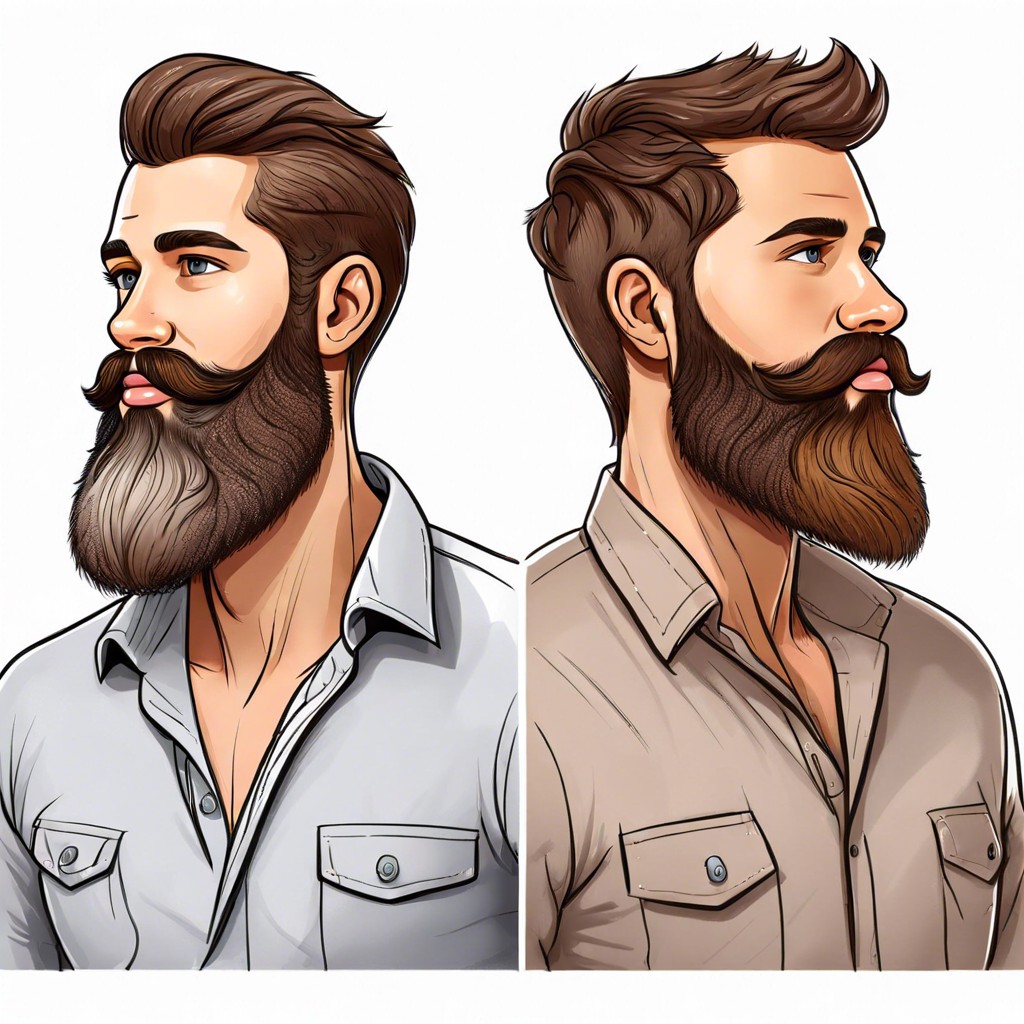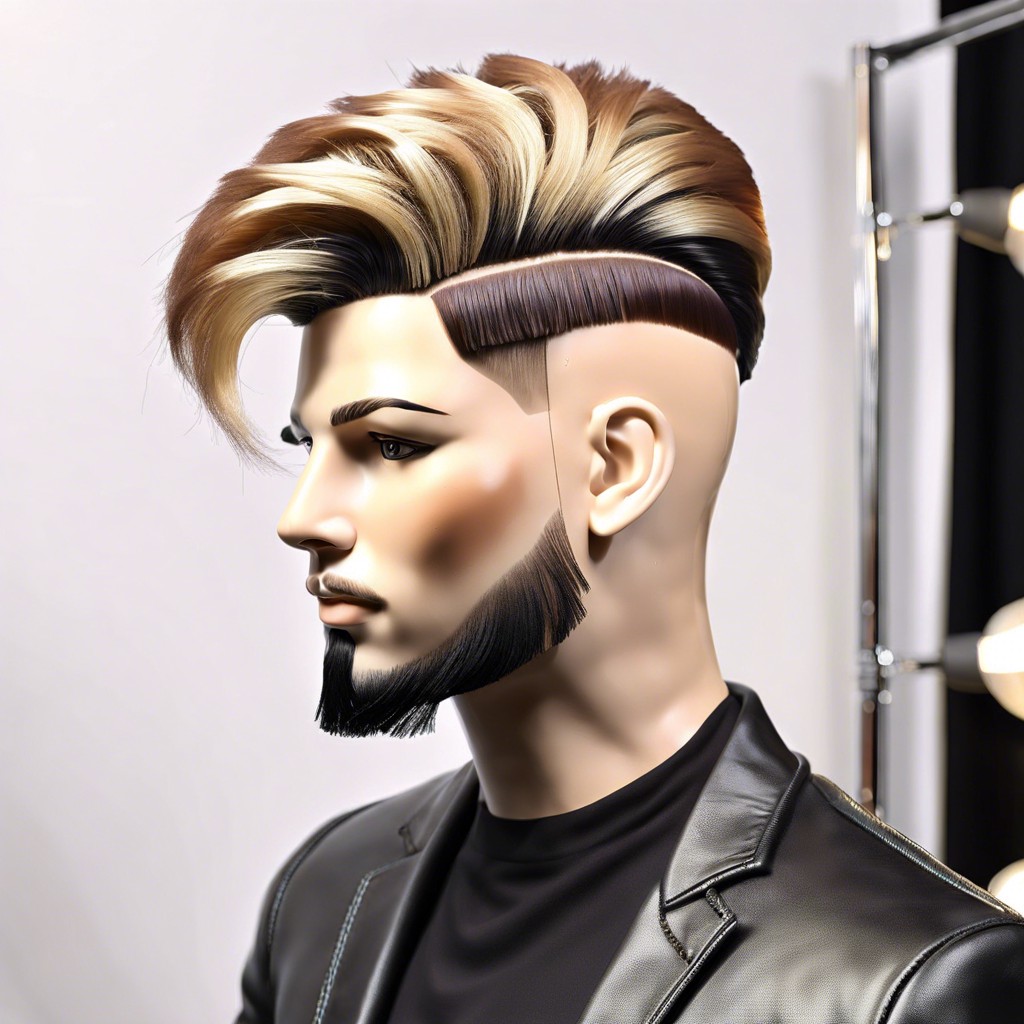Discover how long your beard can grow and learn the factors influencing its growth rate.
Ever wondered why your buddy’s beard grows faster than plot twists in a telenovela, while yours barely sprouts? Welcome to the follicular rollercoaster! Stick around as we unravel the enigma of beard growth phases, delve into the mysteries of genetics, and explore the cosmic dance of hormones. Not only will we decode the impact of diet, grooming habits, and environmental quirks, but we’ll also tackle common beard woes with practical solutions. Curious yet? Let’s dive into the beard odyssey!
Key takeaways:
- Beard growth phases: Anagen, Catagen, Telogen.
- Average growth rate: Half-inch monthly, influenced by age, hormones.
- Genetics: Family traits dictate growth pattern, ethnic influences.
- Diet and nutrition: Vitamins, protein, hydration essential for growth.
- Grooming practices: Hydration, trimming, cleanliness impact growth.
Different Phases of Beard Growth

The journey of facial fuzz is divided into clear steps. First up, the Anagen phase, where hair is actively growing. Picture it as the energetic teen years of your beard—it’s all about speed and vitality. Much like a sprinter, this phase can last a few months to a few years.
Next, we enter the Catagen phase. Think of this as your beard’s gap year. Growth slows as hair follicles shrink, shifting gears into a resting state. This phase is brief, usually a few weeks. Important? Yes. Essential? Absolutely.
Finally, the Telogen phase arrives. The retirement home for your hair follicles. Here, old hairs take a well-deserved break and eventually fall out to make way for new growth. It’s slow and steady, lasting a few months.
Like growth rings in a tree, your beard phases tell a tale of time and transformation.
Average Rate of Beard Growth
Typically, a beard grows about half an inch per month. That’s roughly six inches a year if you’re wondering where you’ll be next movember!
Factors like age and hormonal balance can tweak this rate a bit. Younger folks and those with a higher level of testosterone often see a faster pace.
Stress less about the exact rate. Consistency over speed wins in the beard game.
Even your grade-A diet and quality sleep can play a role, pushing your beard to be its best self.
Don’t sweat the small variations. It’s all part of the beardly journey!
Genetic Factors Influencing Growth
Blame it on your genes! That’s right, Dad might be the reason your beard is more patchy than perfect. Family genetics largely determine beard growth patterns. If your ancestors sported lush facial hair, chances are you will too.
Your ethnicity plays a key role. For instance, men of Mediterranean descent often have thicker beards, while East Asian men might notice slower growth.
It’s all in the DNA mix. Some men have higher levels of certain hair-producing proteins. Androgen sensitivity, particularly to testosterone, further dictates how effortlessly your beard grows.
The beard you wish for might be written in your chromosomes. Science is cool like that.
Importance of Diet and Nutrition
Carrots and kale might just be your beard’s new best friends. Vitamins and minerals play a pivotal role in hair health. Vitamin A, found in veggies like carrots, promotes sebum production, which keeps your beard moisturized and less likely to break.
Protein, found in foods like chicken, fish, and beans, is the building block of hair. No protein? Well, good luck with that scraggly mess! Biotin, often dubbed the “hair growth vitamin,” can be found in eggs and nuts and helps improve keratin infrastructure.
Hydration is another unsung hero. Drinking enough water ensures your beard gets the nutrients it needs, reducing dryness and brittleness. Lastly, those omega-3 fatty acids in fish and flaxseeds? They can help add that enviable sheen to your beard, turning heads wherever you go.
Eating well equals growing well. Your beard will thank you!
Impact of Grooming and Maintenance
Hydration matters. Regularly moisturizing your beard can prevent dryness and breakage, helping it grow longer and stronger. Oils and balms aren’t just for taming wild strands; they nourish the hair and skin underneath.
Trimming might seem counterintuitive, but it’s a game-changer. Periodic trims eliminate split ends, promoting healthier growth. You wouldn’t keep a withered plant, would you?
Cleanliness is next to beardliness. Keeping your beard clean can ward off infections and conditions like dandruff that might inhibit growth. A good beard wash helps remove dead skin cells and other residue.
Brush it real good. Regular brushing stimulates blood flow to the hair follicles, encouraging them to grow. It also helps distribute oils naturally, keeping your beard lush.
Lastly, beware of overwashing. Too much scrubbing can strip natural oils, leaving your beard brittle. Balance is key, and sometimes less is more.
Role of Hormones in Beard Growth
Think of hormones as the DJ at a beard growth party. Testosterone and dihydrotestosterone (DHT) are the stars of the show. These bad boys tell your hair follicles to get busy.
Higher levels of testosterone can mean more robust beard growth. Not feeling the full beard vibe yet? Blame low testosterone. DHT helps determine where the hair will sprout and if it’ll be thick or thin.
Teen guys watch out: puberty is the ultimate beard kickstarter, thanks to hormonal surges. But beware, too much stress can mess with your hormonal harmony, throwing your beard bash into disarray.
Finally, consider this: even with perfect hormone levels, some folks just have less sensitive receptors, meaning their follicles might not respond as enthusiastically. Nature works in mysterious ways!
Environmental Factors Affecting Growth
Got a lush forest on your face, or is it more like a patchy desert? Well, the environment around you might be part of the cause! Dry climates can leave your beard gasping for moisture, making it brittle and prone to breaking. On the flip side, humid conditions can foster a richer garden right under your nose.
Air pollution may stunt your face-foliage. Those tiny particles and toxins can cling to your beard, clogging follicles and messing with healthy growth. Yuck!
Chilly weather calls for scarves. Not just stylish but also protective! Cold air can sap the life out of your beard, leading to a winter wonderland of frizz and split ends.
UV rays love frolicking with your beard in the sunshine. But beware, excessive sun exposure can damage your hair and fade its glorious color.
So next time you curse your mirror about your beard, spare a thought for good old Mother Nature. Your soon-to-be majestic beard is a product of its environment!
Common Growth Issues and Solutions
Patchiness driving you crazy? Fight it with patience and oil! Regular application of beard oil can help stimulate those stubborn follicles. Plus, it keeps your skin happy.
Struggling with slow growth? Check your diet. Lack of essential nutrients like biotin and vitamin D can slow things down. Eat your veggies, folks!
Split ends making a not-so-great comeback? Time for a trim. A tiny snip can promote healthier growth and banish those pesky splits.
Dry, itchy beard? Hydrate. Use a quality beard moisturizer. Nobody likes a scratchy beard, after all.
Got an awkward phase beard? Embrace it. Stick with the grooming routine. Shape it up gently, and remember, even Thor had to start somewhere.
Boom. Problem solved.
Differences in Growth Between Individuals
Beard growth is a mixed bag, my friend. Think of it like a treasure chest; you never know what you’ll find.
Genetics plays a starring role. If your dad and granddad rocked impressive face forests, you’re probably in good company.
Hormones are another biggie. Testosterone levels can make or break your beard game. Simply put, more testosterone can mean more lush growth.
Age is a sneaky factor. While some sprout whiskers in their teens, others might need to wait until their roaring twenties—or beyond!
Health isn’t just a cliché. A balanced diet and good hydration work wonders. Junk food and lack of care? Not so much.
Stress, surprisingly, can also stunt growth. So, relax and let those whiskers breathe.
Everyone’s journey is different. Embrace the unique adventure that is your beard growth!


